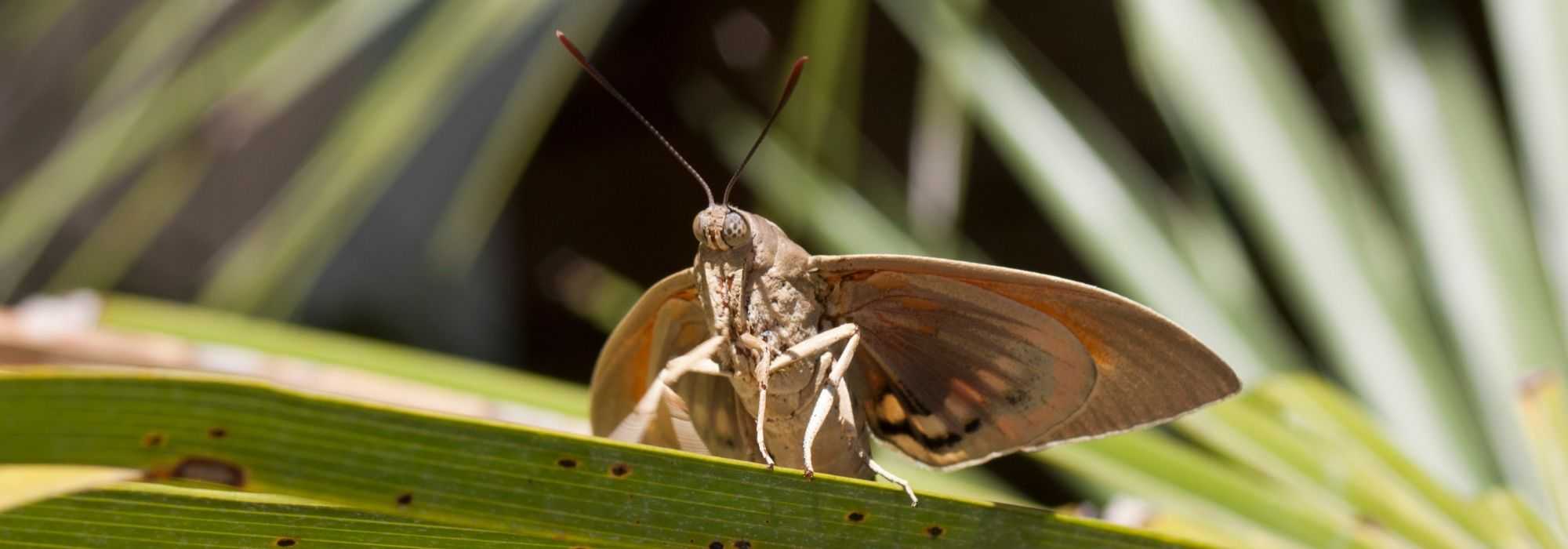
Palm moth, Paysandisia archon : control and treatment
to eliminate this pest
Contents
If palms are generally not very susceptible to common garden pests, the larva of the Argentine palm moth Paysandisia archon constitutes a real scourge, having spread from the south of France since its accidental introduction in 1997.
Its devastation, which extends around the Mediterranean basin and the south-west region, adds to that caused by the larva of another insect, from the beetle family this time, the red palm weevil (Rhynchophorus ferrugineus) introduced to France in 2006.
These two palm larvae most often lead to the tree’s death within a few years.
Authorities therefore urge amateur gardeners to report presence of these two pests to the mayor or to the DRAAF (Regional Directorate for Food, Agriculture and Forest) and to undertake control measures in the hope of limiting their spread across the territory. Here are current ways to protect against them, bearing in mind you should not hesitate to request assistance from your local Parks and Green Spaces Service, which is sometimes actively involved, or from your region’s Plant Health and Protection Service.
Which species are susceptible to the palm borer Paysandisia archon?
Moth Paysandisia archon can attack over 20 palm species but most serious damage in France initially affected most common species, namely :
- Chinese windmill palm (90% of them were thus decimated in Montpellier),
- Canary date palm
- and dwarf palm.
Weevil particularly targets genus Phoenix which includes Canary date palm (Phoenix canariensis) and date palm (Phoenix dactylifera). Frequency of these palm species in Midi gardens contributes to spread of these pests which, after their morphosis, mate and seek new, easy-to-find egg-laying sites.
How to recognise an attack by Paysandisia archon?
It is not always easy to detect the Paysandisia archon moth despite its fairly large size, day‑flying habit and brightly coloured wings. It can be seen from late April to late September, with sightings most frequent in mid‑July.
Wingspan when wings are spread can reach 11 cm. Upper wings are bronze streaked with brown and largely cover the red‑orange lower wings at rest, making it less conspicuous. To recognise it easily, note that the pattern on the lower wings resembles a Halloween pumpkin marked by a row of white teeth bordered above and below by a black band.
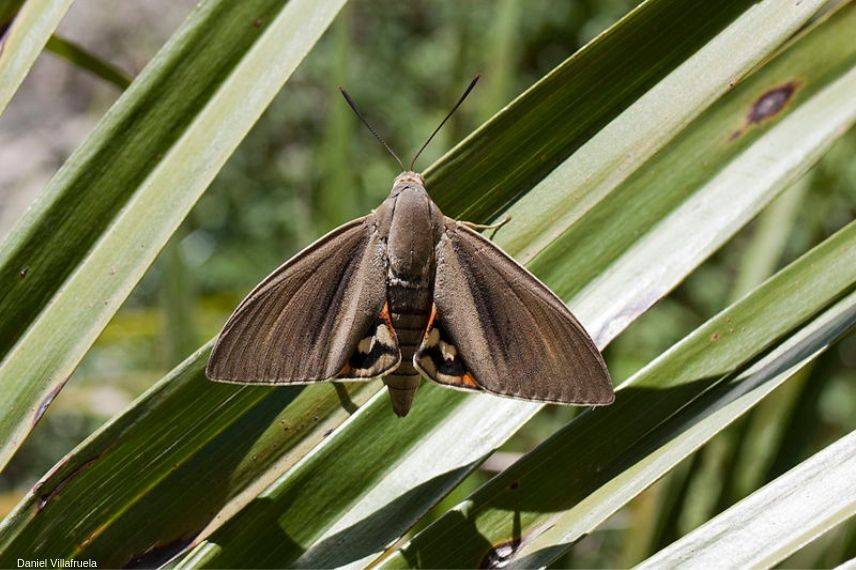
Palm moth or palm borer
First symptoms really visible appear on palms several months after caterpillars penetrate the top of the trunk, just beneath the crown of green fronds :
- Presence of fronds regularly perforated in lines across the width of the fan formed by the frond leaves no doubt about caterpillar activity. Unfortunately this symptom is not always observable, since fronds may sometimes show only chewed or dried areas.
Other signs can, however, help detect presence of the palm borer caterpillar between mid‑May and September, such as :
- Piles of brown sawdust from caterpillar frass in clumps or ribbons on the petiole, the vein of the frond, on young emerging leaves or on the trunk.
- New fronds forming a narrow plume because petioles fail to elongate.
- Characteristic sound of larvae cutting internal fibres of the palm when you press your ear to the trunk in spring or autumn.
- The stipe (trunk) sometimes growing at an angle or becoming deformed.
- Fronds drying out on one side only.
- Presence at the base or on the trunk of shed chrysalis skins (exuviae). Cocoons are generally placed at the base of inflorescences (between brown boat‑shaped bracts), at the base of fronds or in the fibres lining the trunk.
- Gum or a viscous liquid marking gallery entrances.
- Holes corresponding to caterpillar exit points located at the base of fronds.
- Galleries bored into the trunk, visible when the trunk is cut, confirm passage of Paysandisia caterpillars.
When several caterpillars have entered a palm, this usually results in death of the tree within 3 to 4 years. Some palms may show only foliar symptoms without further decline if the larva has disappeared.
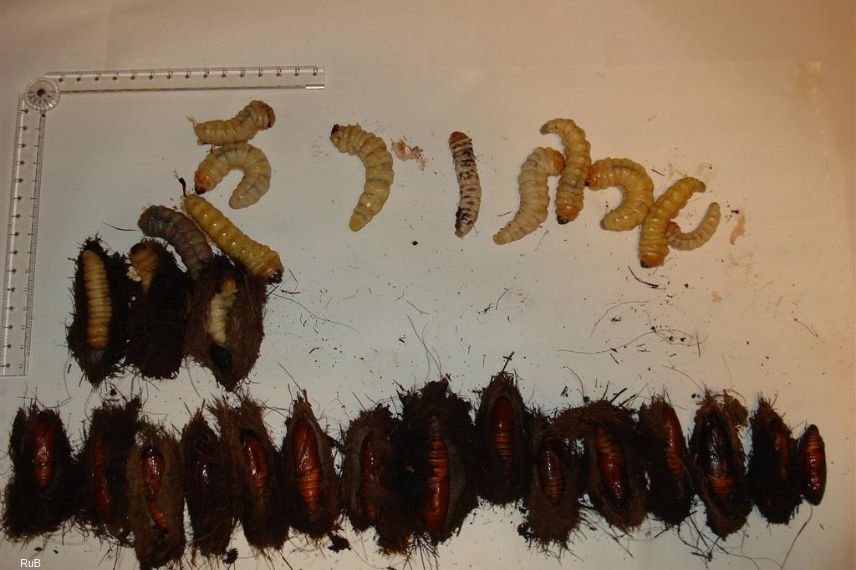
Gathering of Paysandisia archon caterpillars on young Trachycarpus
Discover other Palm trees
View all →Available in 5 sizes
Available in 1 sizes
Available in 1 sizes
Available in 1 sizes
Available in 1 sizes
Available in 4 sizes
Available in 2 sizes
Available in 1 sizes
Available in 1 sizes
Factors favouring Paysandisia archon moth
Fine weather and heat favour the butterfly’s egg‑laying. The presence of many palms in gardens provides an ideal food source for this caterpillar, which can feed only on palms.
To understand how to control it, it is useful to know the butterfly’s cycle:
- Female lays her eggs in the fibres of the palm at the base of the first crowns from mid‑June to mid‑October. The palm butterfly produces only one generation per year but its complete life cycle ranges between one and two years.
- Elongated eggs, less than 5 mm long, are often in small groups of around ten eggs and hatch after 2 to 3 weeks.
- Young caterpillars, under 1 cm long, cream‑coloured and sausage‑shaped like the Michelin Man, quickly penetrate the heart of the palm. Very voracious, their size multiplies tenfold, reaching 9 cm after 11 months (following a summer laying with an annual cycle) or 19 months (following an autumn laying with a biennial cycle) before forming a cocoon to become a butterfly after 2 to 3 weeks.
Read also
Controlling red palm weevilTreat palms against Paysandisia archon moth
Besides awareness and information campaigns on control of the palm‑devouring moth whose devastating effects disfigure landscape, some local authorities offer assistance to private palm owners.
Several methods have been tried, sometimes costly, restrictive and reserved for professionals because of possible toxicity for environment and user. Those that seem easiest for amateur gardeners are application of microscopic nematodes Steinernema carpocapsa (brands Nemapalmier, Palmanem…) presented as powder mixed with clay, and/or use of glue (brand Biopalm) which forms protective film against moth egg laying.
Nematodes Steinernema carpocapsa
This is a biological control technique using living organisms like ladybirds against aphids rather than pesticidal products. It also acts against red palm weevil but is absolutely harmless to other insects, animals or people who come into contact with product.
How does nematode act?
Nematode enters caterpillar or grub through natural openings and multiplies there until causing death after a few days.
When to apply?
As soon as you notice dying palms nearby or if signs described above alert you, obtain box of Steinernema carpocapsa ensuring shelf life.
Apply this solution once a month from March or April (internal temperature of palm must be between 12 and 25°C) and until October. You may skip treatment in July and August if temperature exceeds 35°C at palm centre.
How to apply?
A sachet containing 50 million nematodes is diluted in 10 l of water and treats 1 to 5 trees depending on size.
- Choose a time not too hot in day that follows rain or otherwise make sure to thoroughly moisten top of trunk and base of leaves. This film of water is necessary for nematodes to reach caterpillars.
- Mix entire contents of powder sachet into watering can or sprayer in half of required water stirring for 3 minutes then top up with remaining water.
- Use suspension immediately after preparation, continuing to agitate container.
- Spray top of stipe all around and up to 1 m in height and base of crown.
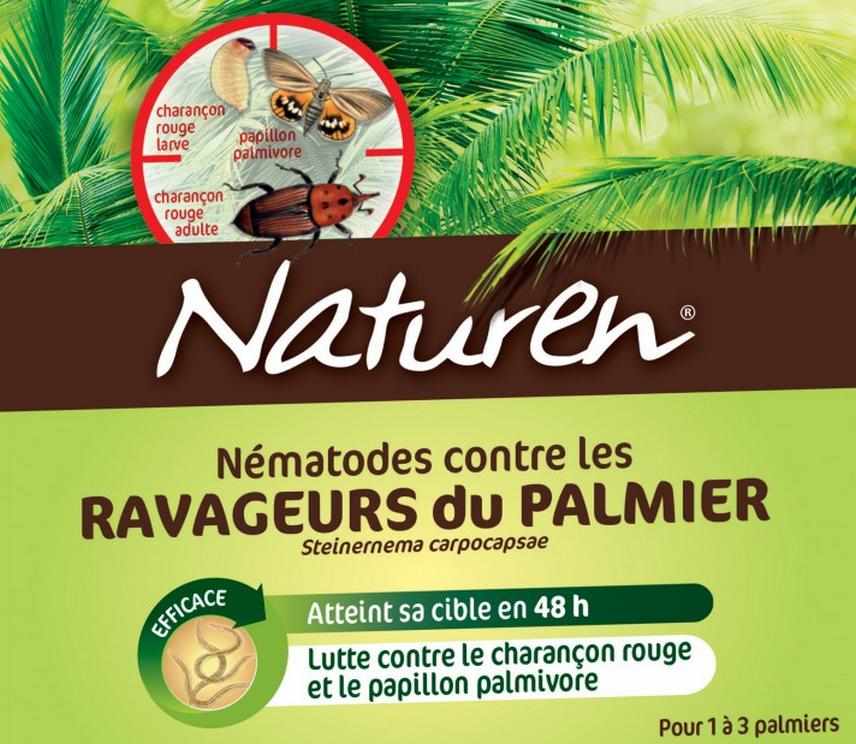
Biopalm glue
How does glue act?
This sticky substance patented by INRA is applied preventively, preferably before egg laying and constitutes physical barrier that discourages moth from laying eggs and also prevents young moth from taking flight when emerging from cocoon. If larvae are already inside trunk, glue has no effect on their destructive action!
Glue is made from natural plant‑based substances (vegetable oils, latex and rosin from pine) completely safe for health. It is sold as 400 ml aerosol, 1 l bottle or 5 kg bucket.
When to apply?
Glue is applied once a year against moth grub when no risk of rain is forecast in next 24 hours. Leaves of current year must already have grown, i.e. between 15 June and 15 July, bearing in mind peak egg laying occurs in first two weeks of July.
Against red palm weevil, two applications are recommended, spaced 4 to 7 months apart, knowing that effectiveness on this pest is not complete.
How to apply?
A suitable sprayer is required to apply this fluid paste unless spreading with spatula in two successive coats a few minutes apart to achieve 2 mm thickness. Aerosol is handy for small specimens but requires positioning at 30 cm from treatment area.
- Start by removing old trailing or horizontal leaves from tree by cutting at base of petiole.
- Apply paste 20 to 30 cm in height below first leaves thoroughly covering fresh scars left by pruning (this limits release of substances attractive to red palm weevil) and base of each leaf on both sides: cover 20–25 cm length of leaf base on Phoenix (Canary date palm) and Washingtonia and only 10–15 cm on Chinese windmill palm and dwarf palm.
Product forms whitish coating on application, then colours amber and becomes inconspicuous after few hours.
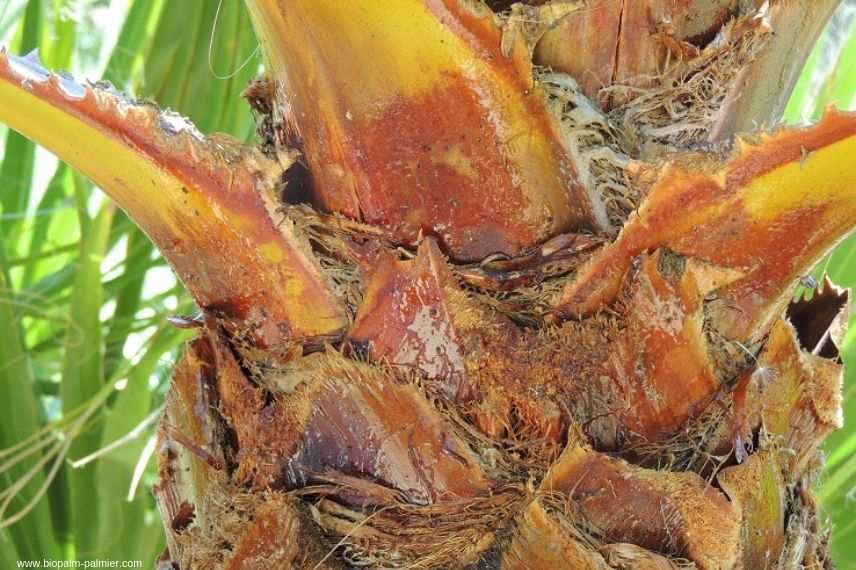
Appearance of Washingtonia after application of Biopalm
Note: another biological control treatment exists using fungus Beauveria bassiana (Ostrinil) but application is reserved for professionals. It acts on all moth stages (egg, caterpillar, adult) and is applied every three weeks from early June to September.
What should I do if my palm tree has died?
Heart is rotten and fronds come away when pulled even if still green. When tree is dead, a felling followed by burning (authorised in this case) is obligatory to prevent new moths emerging from trunk.
Find out more
Find all our tips on palms:
- Palms: plant, grow and maintain
- Which palm for my garden
- 7 hardy palms to plant almost anywhere in France
- Potted palms: 7 remarkable species for indoors
- Subscribe!
- Contents
































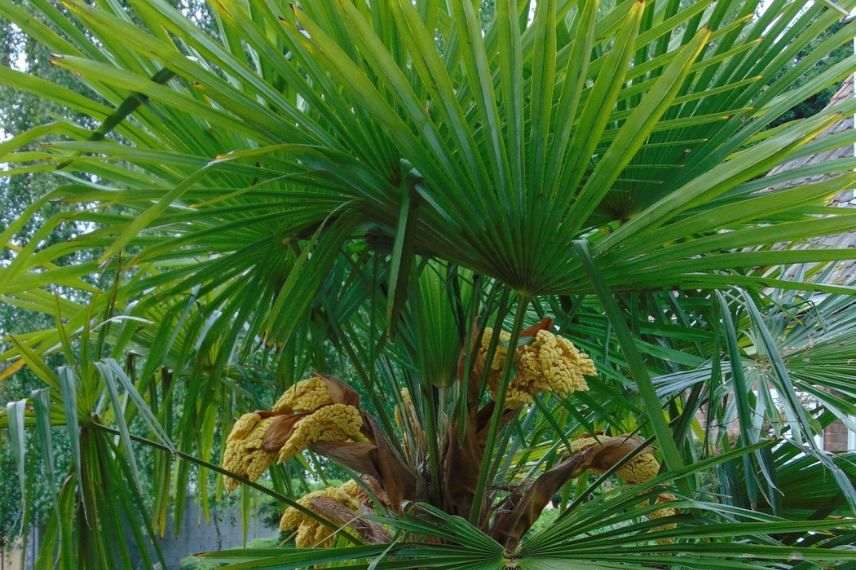
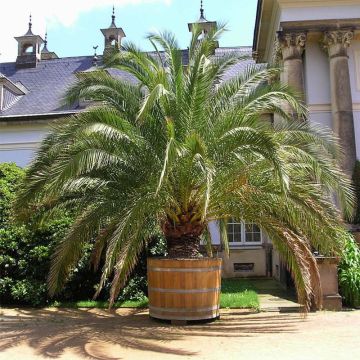
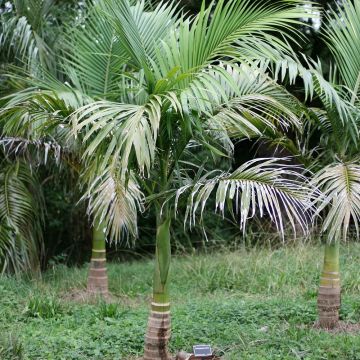

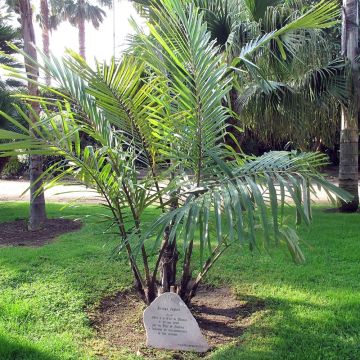
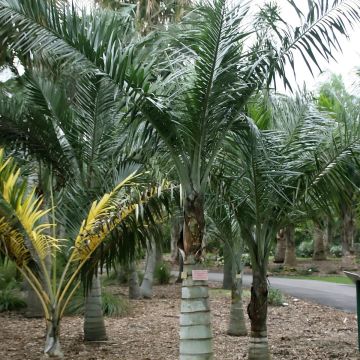
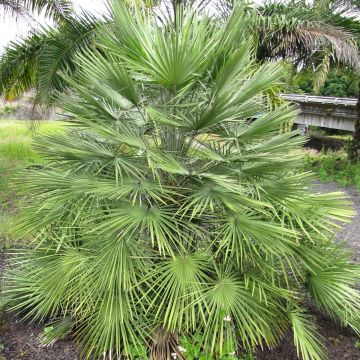

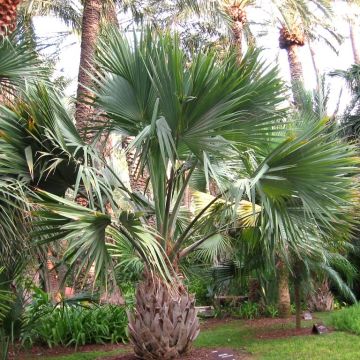
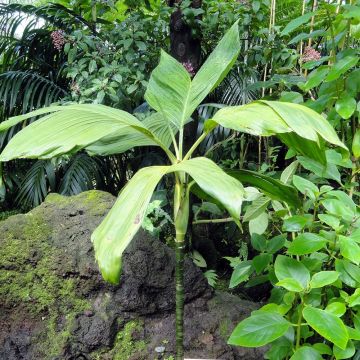

Comments